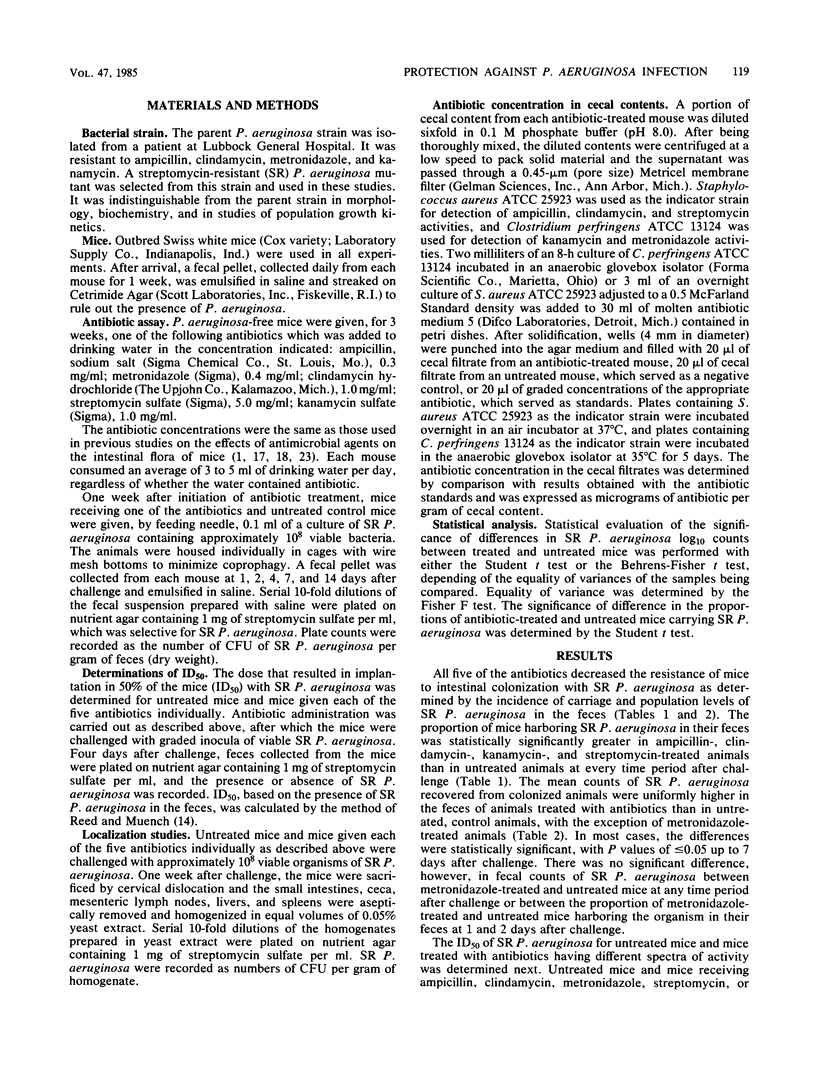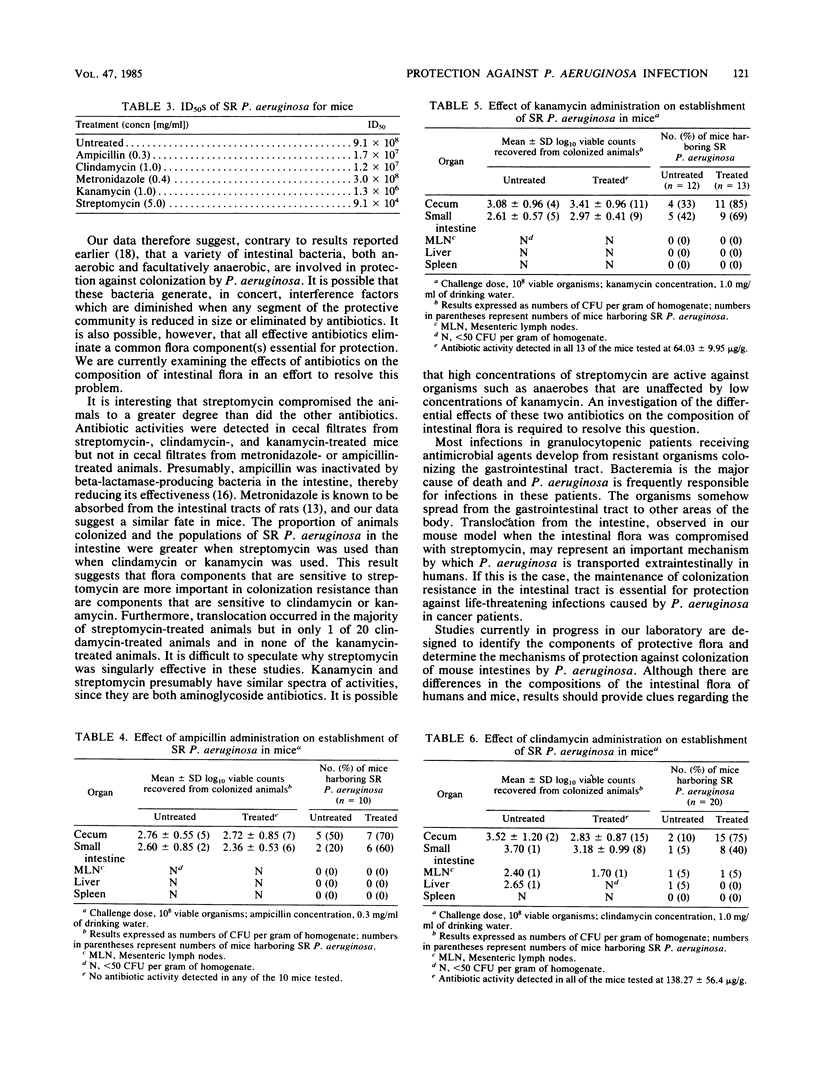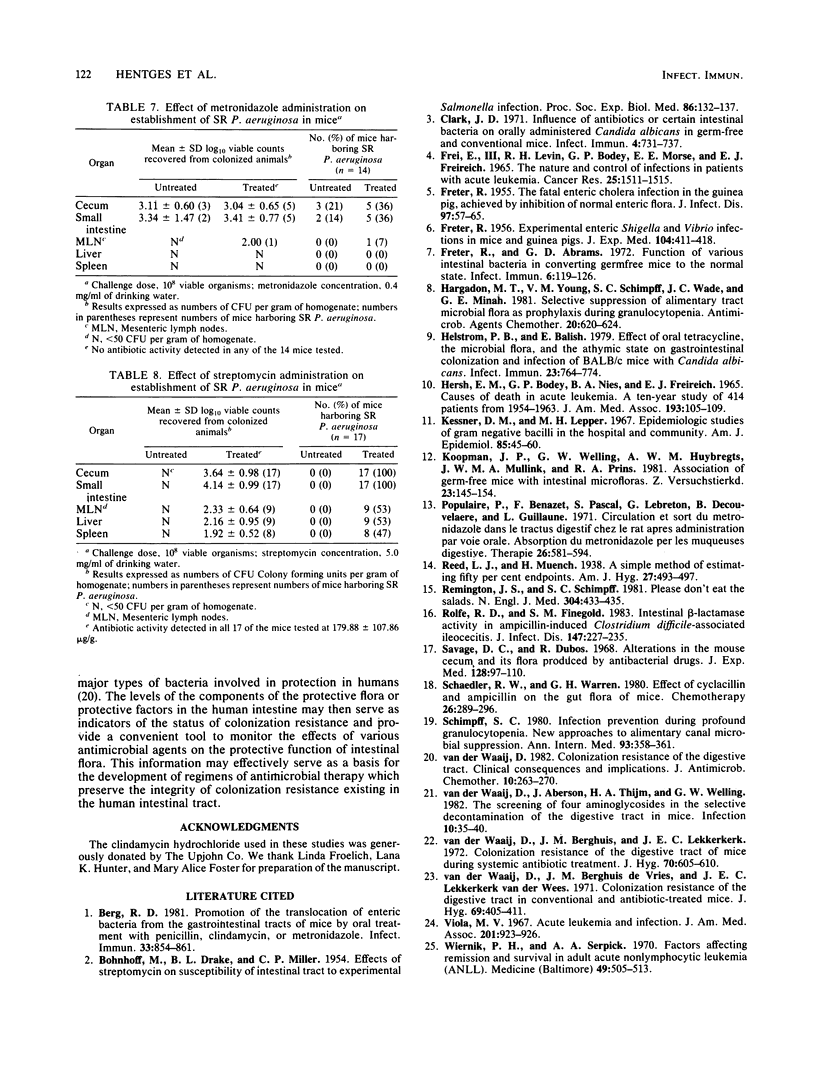Abstract
Swiss white mice were given ampicillin, clindamycin, kanamycin, metronidazole, or streptomycin in drinking water for a period of 3 weeks. One week after the initiation of antibiotic administration, the treated mice and untreated control mice were challenged orally with approximately 10(8) viable, streptomycin-resistant (SR) Pseudomonas aeruginosa isolates. All five of the antibiotics decreased the resistance of the mice to intestinal colonization with SR P. aeruginosa, as reflected by an increased fecal carriage of the organism and an increase in population levels of SR P. aeruginosa in feces as compared with untreated controls. Metronidazole was least effective in this regard. The antibiotics lowered the dose of SR P. aeruginosa that resulted in implantation in 50% of the mice ID50 to various degrees. Administration of streptomycin, the most effective antibiotic, caused a 10,000-fold decrease in ID50 as compared with untreated controls. Oral inoculation of approximately 10(8) organisms of SR P. aeruginosa resulted in translocation of the organism to the mesenteric lymph nodes, spleens, or livers of 13 or 17 streptomycin-treated mice, 1 of 20 clindamycin-treated mice, and 1 of 14 metronidazole-treated mice. Translocation was not observed, however, in ampicillin- or kanamycin-treated animals. Antibiotic activity was detected in the cecal contents of streptomycin-, kanamycin, and clindamycin-treated mice but not in the cecal contents of ampicillin- or metronidazole-treated animals.
Full text
PDF




Selected References
These references are in PubMed. This may not be the complete list of references from this article.
- BOHNHOFF M., DRAKE B. L., MILLER C. P. Effect of streptomycin on susceptibility of intestinal tract to experimental Salmonella infection. Proc Soc Exp Biol Med. 1954 May;86(1):132–137. doi: 10.3181/00379727-86-21030. [DOI] [PubMed] [Google Scholar]
- Berg R. D. Promotion of the translocation of enteric bacteria from the gastrointestinal tracts of mice by oral treatment with penicillin, clindamycin, or metronidazole. Infect Immun. 1981 Sep;33(3):854–861. doi: 10.1128/iai.33.3.854-861.1981. [DOI] [PMC free article] [PubMed] [Google Scholar]
- Clark J. D. Influence of antibiotics or certain intestinal bacteria on orally administered Candida albicans in germ-free and conventional mice. Infect Immun. 1971 Dec;4(6):731–737. doi: 10.1128/iai.4.6.731-737.1971. [DOI] [PMC free article] [PubMed] [Google Scholar]
- FRETER R. Experimental enteric Shigella and Vibrio infections in mice and guinea pigs. J Exp Med. 1956 Sep 1;104(3):411–418. doi: 10.1084/jem.104.3.411. [DOI] [PMC free article] [PubMed] [Google Scholar]
- FRETER R. The fatal enteric cholera infection in the guinea pig, achieved by inhibition of normal enteric flora. J Infect Dis. 1955 Jul-Aug;97(1):57–65. doi: 10.1093/infdis/97.1.57. [DOI] [PubMed] [Google Scholar]
- Frei E., 3rd, Levin R. H., Bodey G. P., Morse E. E., Freireich E. J. The nature and control of infections in patients with acute leukemia. Cancer Res. 1965 Oct;25(9):1511–1515. [PubMed] [Google Scholar]
- Freter R., Abrams G. D. Function of various intestinal bacteria in converting germfree mice to the normal state. Infect Immun. 1972 Aug;6(2):119–126. doi: 10.1128/iai.6.2.119-126.1972. [DOI] [PMC free article] [PubMed] [Google Scholar]
- HERSH E. M., BODEY G. P., NIES B. A., FREIREICH E. J. CAUSES OF DEATH IN ACUTE LEUKEMIA: A TEN-YEAR STUDY OF 414 PATIENTS FROM 1954-1963. JAMA. 1965 Jul 12;193:105–109. doi: 10.1001/jama.1965.03090020019005. [DOI] [PubMed] [Google Scholar]
- Hargadon M. T., Young V. M., Schimpff S. C., Wade J. C., Minah G. E. Selective suppression of alimentary tract microbial flora as prophylaxis during granulocytopenia. Antimicrob Agents Chemother. 1981 Nov;20(5):620–624. doi: 10.1128/aac.20.5.620. [DOI] [PMC free article] [PubMed] [Google Scholar]
- Helstrom P. B., Balish E. Effect of oral tetracycline, the microbial flora, and the athymic state on gastrointestinal colonization and infection of BALB/c mice with Candida albicans. Infect Immun. 1979 Mar;23(3):764–774. doi: 10.1128/iai.23.3.764-774.1979. [DOI] [PMC free article] [PubMed] [Google Scholar]
- Kessner D. M., Lepper M. H. Epidemiologic studies on gram-negative bacilli in the hospital and community. Am J Epidemiol. 1967 Jan;85(1):45–60. doi: 10.1093/oxfordjournals.aje.a120674. [DOI] [PubMed] [Google Scholar]
- Koopman J. P., Welling G. W., Huybregts A. W., Mullink J. W., Prins R. A. Association of germ-free mice with intestinal microflora. Z Versuchstierkd. 1981;23(3):145–154. [PubMed] [Google Scholar]
- Populaire P., Benazet F., Pascal S., Lebreton G., Decouvelaere B., Guillaume L. Circulation et sort du métronidazole dans le tractus digestif chez le rat après administration par voie orale. Absorption du métronidazole par les muqueuses digestives. Therapie. 1971 May-Jun;26(3):581–594. [PubMed] [Google Scholar]
- Remington J. S., Schimpff S. C. Occasional notes. Please don't eat the salads. N Engl J Med. 1981 Feb 12;304(7):433–435. doi: 10.1056/NEJM198102123040730. [DOI] [PubMed] [Google Scholar]
- Rolfe R. D., Finegold S. M. Intestinal beta-lactamase activity in ampicillin-induced, Clostridium difficile-associated ileocecitis. J Infect Dis. 1983 Feb;147(2):227–235. doi: 10.1093/infdis/147.2.227. [DOI] [PubMed] [Google Scholar]
- Savage D. C., Dubos R. Alterations in the mouse cecum and its flora produced by antibacterial drugs. J Exp Med. 1968 Jul 1;128(1):97–110. doi: 10.1084/jem.128.1.97. [DOI] [PMC free article] [PubMed] [Google Scholar]
- Schaedler R. W., Warren G. H. Effect of cyclacillin and ampicillin on the gut flora of mice. Chemotherapy. 1980;26(4):289–296. doi: 10.1159/000237919. [DOI] [PubMed] [Google Scholar]
- Schimpff S. C. Infection prevention during profound granulocytopenia. New approaches to alimentary canal microbial suppression. Ann Intern Med. 1980 Aug;93(2):358–361. doi: 10.7326/0003-4819-93-2-358. [DOI] [PubMed] [Google Scholar]
- Viola M. V. Acute leukemia and infection. JAMA. 1967 Sep 18;201(12):923–926. [PubMed] [Google Scholar]
- Wiernik P. H., Serpick A. A. Factors effecting remission and survival in adult acute nonlymphocytic leukemia (ANLL). Medicine (Baltimore) 1970 Nov;49(6):505–513. doi: 10.1097/00005792-197011000-00004. [DOI] [PubMed] [Google Scholar]
- van der Waaij D., Aberson J., Thijm H. A., Welling G. W. The screening of four aminoglycosides in the selective decontamination of the digestive tract in mice. Infection. 1982 Jan;10(1):35–40. doi: 10.1007/BF01640836. [DOI] [PubMed] [Google Scholar]
- van der Waaij D., Berghuis-de Vries J. M., Lekkerkerk Lekkerkerk-v Colonization resistance of the digestive tract in conventional and antibiotic-treated mice. J Hyg (Lond) 1971 Sep;69(3):405–411. doi: 10.1017/s0022172400021653. [DOI] [PMC free article] [PubMed] [Google Scholar]
- van der Waaij D., Berghuis J. M., Lekkerkerk J. E. Colonization resistance of the digestive tract of mice during systemic antibiotic treatment. J Hyg (Lond) 1972 Dec;70(4):605–610. doi: 10.1017/s0022172400022464. [DOI] [PMC free article] [PubMed] [Google Scholar]
- van der Waaij D. Colonization resistance of the digestive tract: clinical consequences and implications. J Antimicrob Chemother. 1982 Oct;10(4):263–270. doi: 10.1093/jac/10.4.263. [DOI] [PubMed] [Google Scholar]


